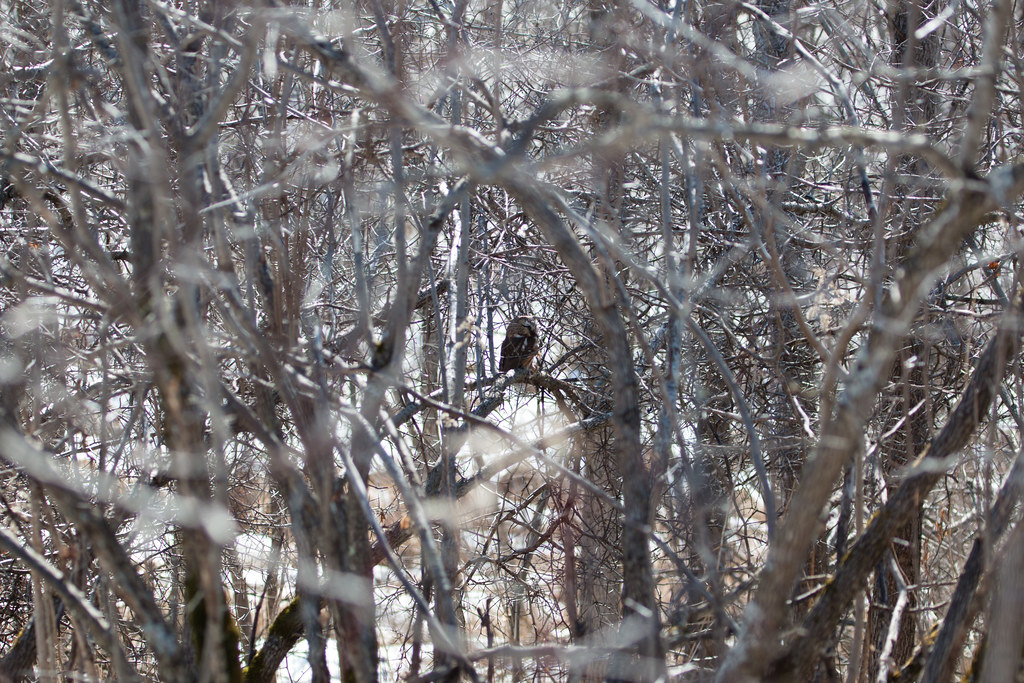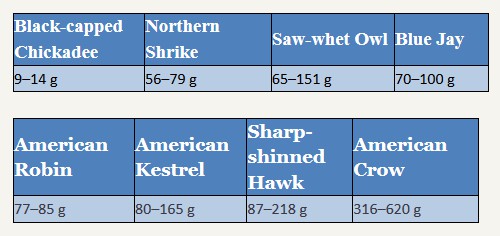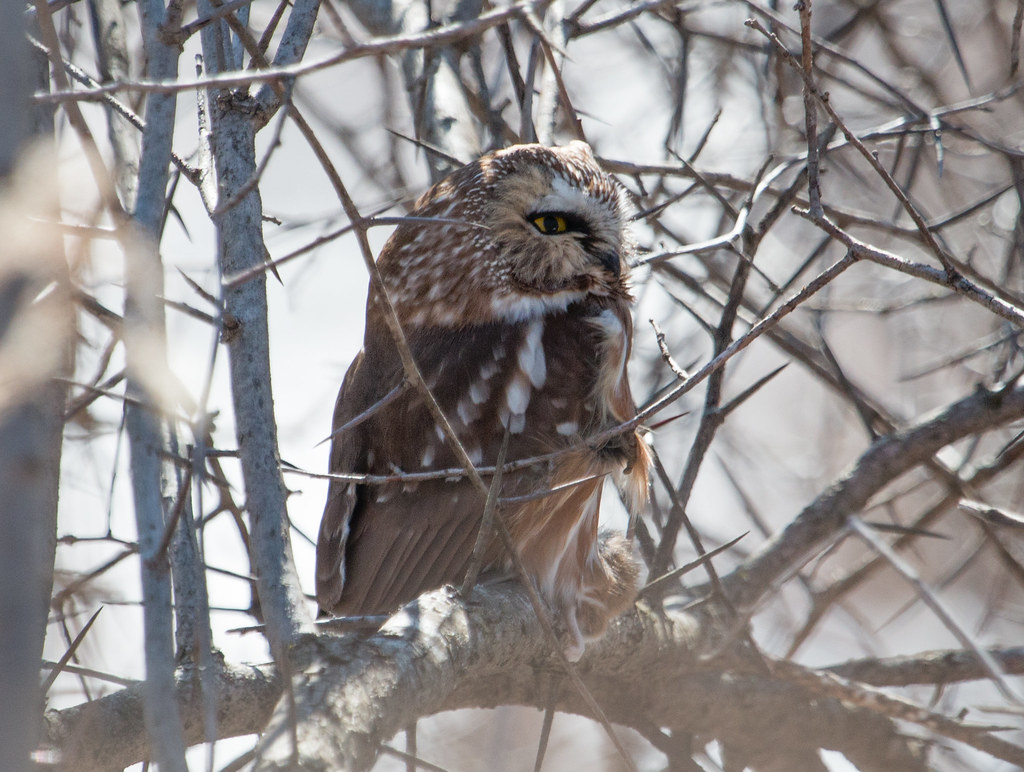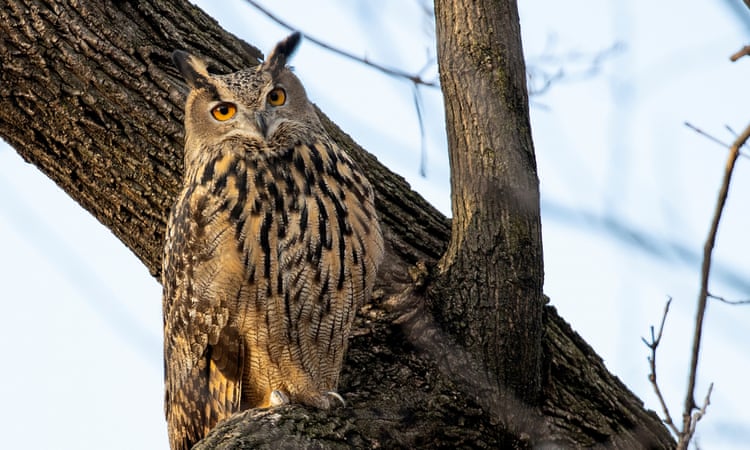One of the only things I love more than the Chicago Cubs is the Black-capped Chickadee, and Saturday, the Cubs and chickadees conspired to bring me some magical Karma when I led a bird walk for Hawk Ridge Observatory along Duluth’s Western Waterfront Trail.
It was warm for early March—it didn’t freeze the night before, and was already almost 40 when I left home in the morning, and so I decided to wear my Cubs cap. While our group was gathering in the parking lot, we saw geese, crows, and chickadees, and then started on the trail. We’d only gone a short way when we stopped to watch the chickadees.
They were all about, chickadee-dee-deeing at us, so I explained how helpful chickadees are for us when cool migrants are passing through, because warblers and vireos gravitate to chickadee flocks when they find themselves in unfamiliar areas. Chickadees welcome any birds that aren’t predators into their flocks and know where all the best food sources and all the dangers may be.
Trees hadn’t budded out yet, so we were days or weeks from the first warblers, but I thought this would be interesting information. Anyway, as I blathered on, it suddenly occurred to me that as cooperative as chickadees usually are when I lead field trips, these birds were sticking around much longer than they usually do, and were doing a LOT of chickadee-dee-deeing.
And those chickadee-dee-dee calls had more dee notes than usual. So as I talked, I started scanning the branches of the nearby shrubs. And what to my wondering eyes should appear, but a miniature owl! Right there before us!
The Northern Saw-whet Owl is the littlest owl in the Midwest. The tiny male weighs only about 2 ½ ounces—less than the smallest American Kestrel or Sharp-shinned Hawk, and barely more than a smallish Northern Shrike—larger shrikes, robins, and Blue Jays can outweigh even healthy male Saw-whets.
Being so tiny, saw-whets are quite vulnerable to predation. By night, they’re ever alert as they hunt or call, and by day, they usually hide in a tree cavity. During migration, though, they don’t always know where a cavity is, or if they do notice one, it’s likely to already belong to a woodpecker, flying squirrel or someone else. If they can’t find a cavity, they usually roost in the thick branches of a conifer. It’s exceptional to find one in bare deciduous branches, though their cryptic colors and tiny size do afford some protection.
Our group was thrilled to see the little guy. He opened his eyes half way part of the time, but mostly kept them almost entirely closed. Chickadees and other birds go ballistic when they see the yellow eyes of any owl or cat, and owls can see perfectly well when their eyes are open just a slit. When we got there, chickadees weren’t dive-bombing it or even gathering in the same shrubs with the little owl, who seemed determined to help them forget about it. Even as it kept its little face toward us, it kept its eyes mostly closed, appearing to be asleep.
Eventually the chickadees wandered off, and we moved on to give the little guy some rest. Just in case, we stopped back on the way back to our cars 2 ½ hours later, and the owl was in the exact same place. It wasn’t until I was home and looking through my photos that I realized why it was sitting so tight and hadn’t retreated to a denser tree. It was holding in its talons a mouse—or at least the back half of one. It didn’t want to risk dropping its meal if it could just stick it out for the rest of the day.
I presume it had had good luck the night before, and that this was a second or even third mouse of the night. Once their stomach is full, they don’t swallow anything more until they’ve formed and spit out a pellet.
This is precisely the season for Northern Saw-whet Owls to be migrating. If you’re out in the middle of the night when there’s little wind, you might hear one calling, but picking one out in the daytime requires luck. That’s where my Cubs hat entered the picture. It can hardly be a coincidence that the first time I ever wore a Cubs cap to lead a bird walk happened to be the very first time I ever spotted a Saw-whet Owl for my group on a bird walk. And of course I’d never have been scanning all the branches had it not been for the chickadees. Aftyer all, that bold letter C on my cap stands for both Chicago Cubs and Chickadees.
I’ll be wearing that cap whenever I go birding through October. Even if I don’t see another cool or rare bird, this Saw-whet owl was plenty for me. I only hope my wearing the cap brings the Cubs as much luck as it brought me. 2016 really should be their year.
Laura Erickson
Laura Erickson, 2014 recipient of the American Birding Association’s prestigious Roger Tory Peterson Award, has been a scientist, teacher, writer, wildlife rehabilitator, professional blogger, public speaker, photographer, American Robin and Whooping Crane Expert for the popular Journey North educational website, and Science Editor at the Cornell Lab of Ornithology. She’s written eight books about birds, including the best-selling Into the Nest: Intimate Views of the Courting, Parenting, and Family Lives of Familiar Birds (co-authored by photographer Marie Read); the National Outdoor Book Award winning Sharing the Wonder of Birds with Kids; 101 Ways to Help Birds; The Bird Watching Answer Book for the Cornell Lab of Ornithology; and the National Geographic Pocket Guide to Birds of North America. She’s currently a columnist and contributing editor for BirdWatching magazine, and is writing a field guide to the birds of Minnesota for the American Birding Association. Since 1986 she has been producing the long-running “For the Birds” radio program for many public radio stations; the program is podcast on iTunes. She lives in Duluth, Minnesota, with her husband, mother-in-law, licensed education Eastern Screech-Owl Archimedes, two indoor cats, and her little birding dog Pip.







Leave a Reply